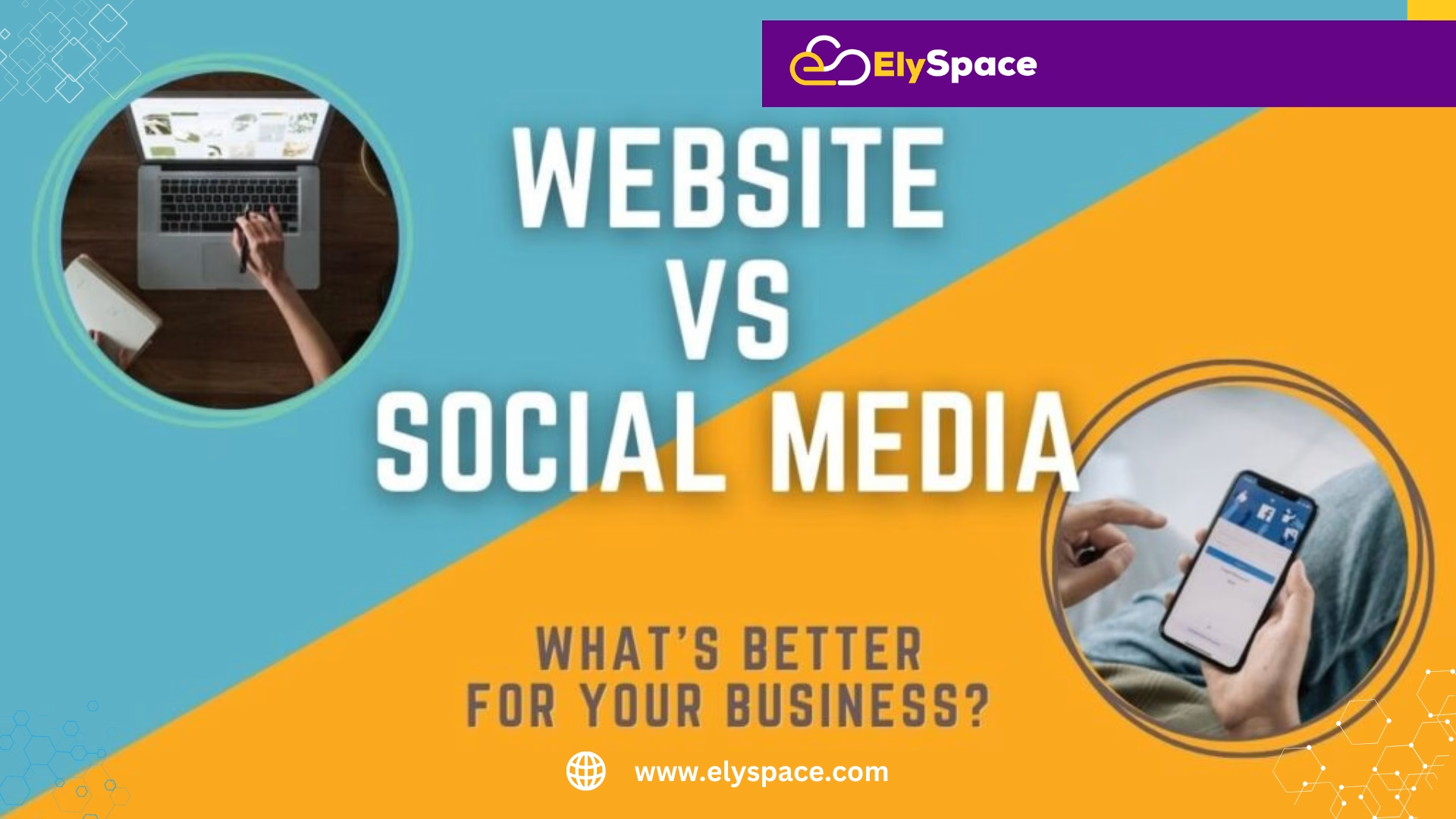Website vs Social Media : Increasingly, businesses must now decide where to put their money in building a business location: a website or through social media marketing. This guide will help explore how to think through a website and/orsocial media marketing strategy so that you can come to a reasonable decision for your business.
A Digital Marketing Ecosystem Overview : Website vs Social Media
Over the past 10 years, the digital marketing ecosystem has changed dramatically from the simpler, less fragmented structure of the past. With an estimated global population of 7.88 billion and over 5.16 billion of those being internet users (more than 66% of the population), there are also over 4.76 billion social media users (which is also more than 84% of internet users). Digital marketing via the internet has created a potentially infinite number of traditional and new ways to get messaging out to audiences, as well as the ability to measure the messaging. While it’s now easier than ever to engage in digital marketing, it also brings up new challenges in relation to resource allocation. With so many platforms and touchpoints, where does one focus the budget and human resources?
Current Market Statistics
- Website Contribution to Traffic: 64.4% of the total website traffic is from mobile devices
- Social Media Engagement: The average person spends 2 hours and 31 minutes a day on social media
- Business Environment: 71% of businesses use social media for marketing; 99% of businesses have a website and many have social presence/marketing
- Consumer Behavior: 88% of consumers note that they research online before making a product purchase
Web-Based Businesses: Full Review
Why Is a Business Website Important?
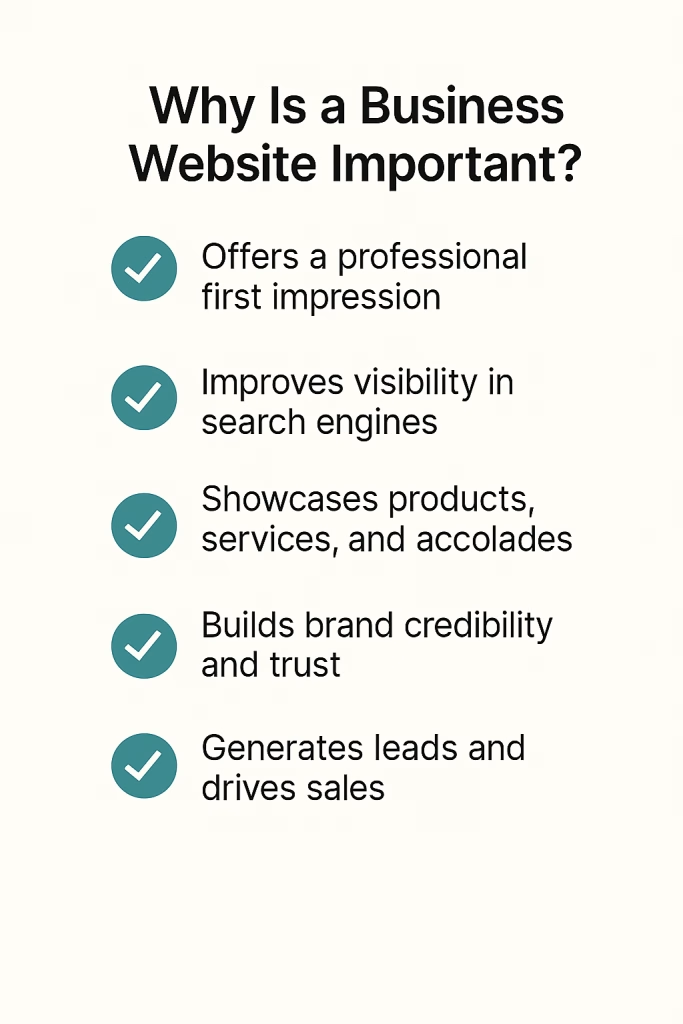
A business website is your digital home base – consumers can find information on your products and services as well as the values behind your brand all in a single place. Websites are not as efficient as social media, but they offer you more control over how users navigate the pages, how content is presented to them, and how you are able to collect data.
Five (5) Major Benefits of Business Websites
1. Complete Control vs Ownership
- Total control over design, functionality, and customer experience
- You own everything published on the website, as well as customer information
- You will not have to worry about losing your presence based on the platform’s decision to change policies
- You can build customized features and integrate the technologies that you want
2. Search Engine Optimization
- Better possibilities of organic search results
- You can focus on the search terms or keywords that you want to use
- Higher local SEO opportunities
- You get longer-term traffic growth with relevant content
3. Professional Credibility
- Level of trust and legitimacy for a brand and organization
- Business email so you look professional. (@yourbusiness.com)
- Provide detailed descriptions of your product or service
- Post customer testimonials and case studies
4. Generate More Leads and Conversions
- Essentially we now have a well-optimised conversion funnel: When you approach the conversion funnel, do it mindfully. Do not fill useContact Forms, Lead-capture, E-commerce: in line with best practice. Do not just be reactive; be proactive.
- With analytics, tracking customer data and behaviour to help us make improvements
5. Content Marketing Hub
- Blog so you can showcase your thought leadership.
- You can have a resource library or other documents for download
- You can provide educational content for customers
- You can have a comprehensive content strategy that focuses on SEO.
Disadvantages of Websites
1. Higher upfront costs
- Development could cost anywhere between $3,000 and a few hundred thousand dollars.
- Ongoing costs, e.g. maintenance, hosting fees, content, updates, security, etc.
- Technical expertise is needed, whether freelance or agency.
2. Takes time to develop authority
- SEO results take about 6-12 months to kick in.
- Developing organic traffic will take a consistent effort
- Creating new content is very resource intensive
- Very competitive in search, so results can vary
3. Marketing needed for traffic
- Not traffic-dense automatically
- Paid advertising/content marketing to get noticed
- Social media management needed
- Email marketing and/or other traffic sources
Social Media for Business: Review summary
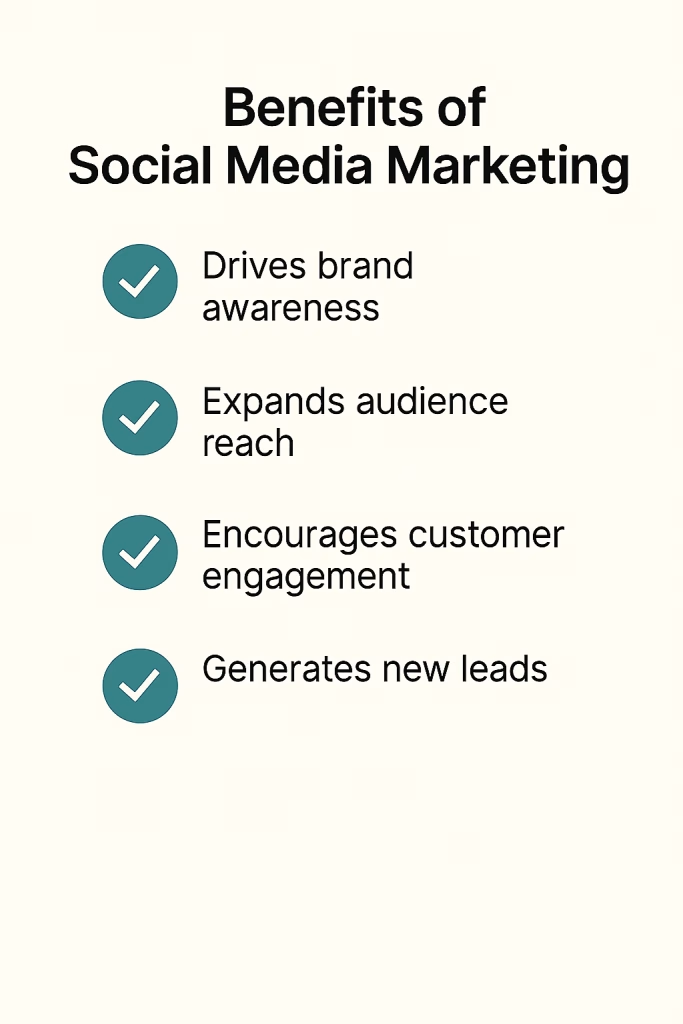
Benefits of Social Media Marketing
Social media marketing is a great marketing channel because it has fundamentally changed the way businesses connect with customers. There are opportunities to create an audience with built-in audiences, targeting available at many levels (age, gender, interests, etc), and the opportunity to create viral content.
Benefits of Social Media Marketing
1. Reach and Targeting
- Access to billions of active users.
- Targeting uses strong demographics and behaviour targeting.
- Reach a variety of niches and communities.
- Global reach locally.
2. Economically affordable, low barrier to entry
- Can create a free account.
- Low minimum to advertising/cost options.
- Potential for organic reach.
- Can create high returns on investment from well-executed campaigns.
3. Real-Time Engagement
- Interactive conversation with customers
- Immediate feedback and responses
- Community-building opportunities
- A customer service and support channel
4. Viral Marketing Potential
- Content can potentially reach millions organically
- User-generated content opportunities
- Working with influencers
- Participating in trending topics
5. Rich Content Formats
- Ability to create video content
- Ability to live stream
- Create stories and temporary content
- Use interactive features (polls, Q&A, etc.)
Disadvantages of Social Media
1. Dependence on Platforms
- You are subject to their algorithms.
- Your account could be suspended or deleted/lost.
- You have no control over their policies.
- You could lose your audience because of changes in the platform.
2. Need for Consistent Content
- You must continue to post to stay visible.
- Algorithms favour recent content.
- There is a high competition for attention.
- There is a risk of burnout relating to content creation.
3. Limited Conversion Opportunities
- Hard to make direct sales.
- There are restrictions on promotions.
- Consumers are mostly browsing without buying intent.
- It can be difficult for users to navigate the customer journey from social to sale.
4. Visibility of Negative Feedback
- You can receive public criticism in complaints.
- There is a risk that negative content could go viral.
- You may not be able to control the narrative.
- Reputation must be monitored 24/7.
Side-by-Side Comparison : Website vs Social Media
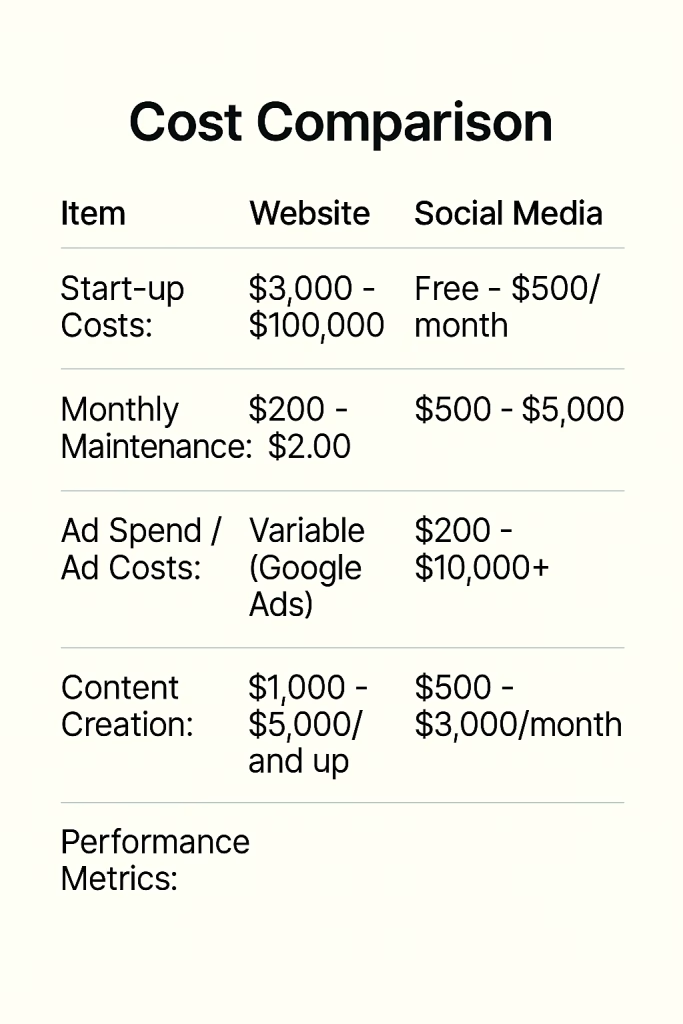
Cost Comparison
Item Website Social Media: Start-up costs: $3,000 – $100,000, Free – $500/month. Your monthly maintenance $200 – $2,000 $500 – $5,000 Ad Spend / Ad Costs Variable (Google Ads) $200 – $10,000+ Content Creation $1,000 – $5,000/month and up $500 – $3,000/month Performance Metrics
Metric Website Advantage Social Media Advantage Conversion Rate: 2-3% average 0.5-1% average Customer Lifetime Value Higher Lower Brand Control Complete Limited Reach Speed: Slow, Fast; SEO Value: High, Low; Engagement Rate: Lower Higher Long-term Value comparison
Website Strengths:
- Building organic traffic that lasts
- Building the overall customer experience
- Establishing credibility and professionalism
- Generating qualified leads
- Supporting a complex sales process
Social Media Strengths:
- Activating brand awareness quickly
- Building loyalty and community
- Sharing content organically in a viral way
- Communicating with customers in real time
- Able to participate or track trending topics or issues and stay relevant
Industry-Specific Recommendations : Website vs Social Media
E-commerce Businesses
Recommendation: Website First
- Essential for catalogs and transaction processes
- SEO that creates high-intent traffic
- Customer Reviews and detailed product information
- Website as funnel from social channels
Professional Services (legal, medical, consulting)
Recommendation: Website First (Balanced Approach)
- Build credibility with website and establish expertise.
- – Use social media to push thought leadership.
- – Explore local keyword SEO, especially for service searches.
- – B2B services can optimise LinkedIn.
Restaurants/Local Businesses.
Recommendation: Social Media First for most cases.
- Visual platforms such as Instagram are ideal for sharing food/ambiance.
- Social media for incentivizing immediate traffic
- Google My Business integration is part of this process.
- Simple website for basic info and potentially reservations.
Content Creators/Personal Brands
Recommendation: Social media-first strategy
- Social platforms provide the first distributor
- Website is your purpose-built portfolio
- Build your email list through both
- Diversifying into multiple platforms
B2B Technology companies
Recommendation: Website-first strategy
- Complicated products need to be explained
- Long sales processes need to be nurtured
- SEO on technical keywords
- Use LinkedIn for professional connections
The Integrated Approach: Website vs Social Media
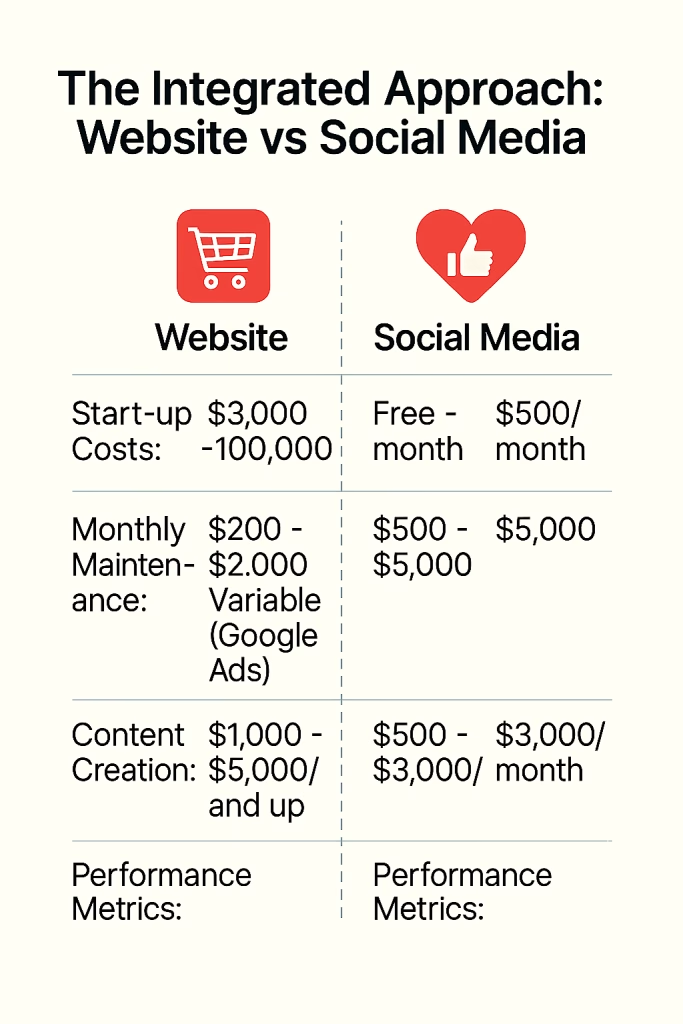
Why the Integration Approach is best
The best businesses do not choose between a website and social platforms, they work them into their practice to take advantage of their strengths and minimize their weaknesses.
Strategic Integrated Approach
1. Content Integration
- Create content on your website
- Share it through your social platforms
- Repurpose and tease on your social platforms
- Send traffic from social to your website
- Start to create a store front with the feedback from your social channels.
2. Leads Integration
- Social media is for awareness and engagement
- Website is for conversion and detailed explanation.
- Nurture your leads from social and website through email marketing and retargeting across all platforms.
3. SEO and Social Signals
- Social engagement activity will support your SEO efforts
- Providing value via the website
- Use for social sharing
- Keep the keywords the same across all your platforms
- Gain social proof to build your website credibility.
Implementation Roadmap
Phase 1 Building on a Foundation (Months 1-3)
- Create a basic website with all the key pages.
- Read from someone else for an example.
- Build a primary social media presence.
- Create the same branding for all platforms.
- Analytics and Tracking Establishment
Phase 2: Content Creation (Months 4-6)
- Launch blog and content strategy
- Monthly social media content calendar
- Lead magnets and opt-ins
- Grow your business email list from both accounts
Phase 3: Optimization & Growth (Months 7-12)
- Consult your performance data
- Optimize your pathways for conversion
- Scale successful content formats
- Add additional platforms, if applicable
Budget Considerations {#budget}
Budget by Stage of Business
Start up (less than or $10,000 annual marketing budget)
- 60% Website: minimal pages and minimum viable SEO
- 30% Social: only one or two
- 10% Tools and analytics: minimal tracking and basic management
Growing Business ($10,000 – $50,000 annual marketing budget)
- 50% Website: nice website and enough content to have a presence
- 35% Social: multiple platforms and boosted/paid
- 15% Tools and integration: analytics and automation
Established Business ($50,000+ annual marketing budget)
- 40% Website: standard functioning website and ongoing optimization
- 45% Social: managed service and paid
- 15% More innovative: into other social platforms and trying out innovative strategies
ROI Measurement Framework
Website ROI Metrics:
- Net organic traffic increase
- Average cost per lead
- Increased conversion rate by specific media type
- Average customer life time value
Social Media ROI Metrics:
- Cost per acquisition
- Engagement changes over a period of time
- Awareness metrics
- Social commerce conversions
Emerging Technologies and the Future
Impact of Some Emerging Technologies
Artificial Intelligence and Automation
- Website Impact: AI-powered personalized content on websites, AI-powered chatbots
- Social Media Impact: AI-powered platforms enabling advanced targeting and content creation.
- Integrative Opportunity: AI makes user experience pretty seamless; how can AI improve customer experience across different platforms.
Voice Search and Smart Speakers
- Website Impact: Voice search will be on the website (optimization).
- Social Media Impact: Audio content formats will become important on social media.
- Strategic Shift: prioritizing conversational content and featured snippets (increasing voice search traffic).
Augmented and Virtual Reality (AR & VR)
- Website Impact: On a website interactive product demos.
- Social Media Impact: AR ‘filters’ and immersive ad spaces.
- Customer Experience: virtual try-ons & experiences.
Future of Platforms
Website Evolution and Predictions
- Faster loading speed (Core Web Vitals)
- Improved mobile experience (Responsive)
- Progressive Web Apps (PWAs)
- AI-generated personalization
Social Media Evolution and Predictions
- Growing e-commerce features
- Short-form videos will dominate social
- Establishment of a creator economy
- Advertising focused on privacy
Action Plan and Recommendations
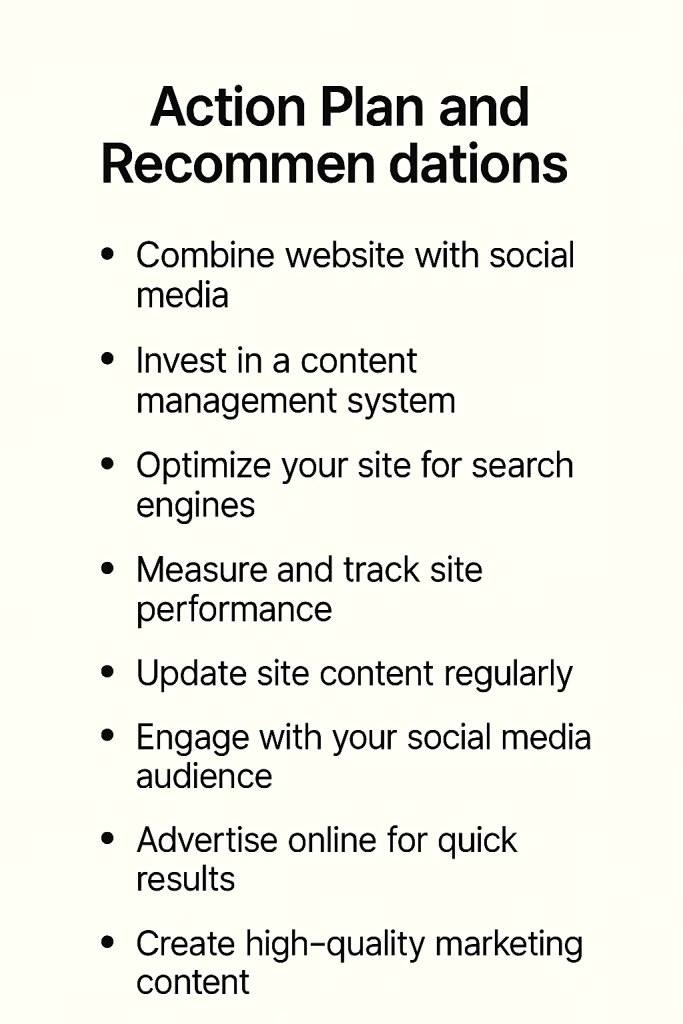
Immediate Actions (Next 30 Days)
Audit current digital footprint
- Complete a full audit of existing presence (website metrics)
- Explore social engagement data (Facebook, Instagram)
- Identify strengths and weaknesses
- Look for opportunities
- Analyze competitor engagement and content
- Need to have basis for tracking
Define Clear Goals
- Define your goals, and ensure they are specific and measurable goals.
- Decide what criteria you will measure success against
- Determine a budget
- Create a timeline for planning
Choose Where to Start
- You should choose which social media platform(s) to work with initially: 1-2
- Initially you will focus in the website essentials
Consider the preference of your audience
Where are you acquiring the resources from to keep this up?
90-Day Implementation Plan
Month 1: Set up the foundation
- Optimize (or build) a website
- Set up and refine social media accounts
- Apply branding to accounts
- Figure out a content strategy
- Implement analytics
Month 2: Create Content
- Develop content for a blog
- A plan for social media content, refine and develop a calendar
- Develop lead magnet
- Set up system for email marketing
Month 3: Promotion and Optimization
- Initiate paid advertising campaign
- Implement Search Engine Optimization (SEO)
- Engage audience through social media
- Analyze results, create a pivot if required
Ongoing Success Plan
Content Creation
- Continue to create and publish content on a regular basis.
- Push quantity over quality
- Make it work across multiple platforms, use snippets or repurpose.
- Continue to evaluate impact and optimize.
Data-Driven
- Evaluate and optimize performance regularly
- Use A/B testing
- Collect feedback from customers
- Continuously optimize.
Community Building
- Communicate transparently and interactively.
- Respond to comments and direct messages.
- Create content that is valuable enough to be shared.
- Develop a community for community’s sake, not just for followers.
Conclusion: The Best Approach for Your Business : Website vs Social Media
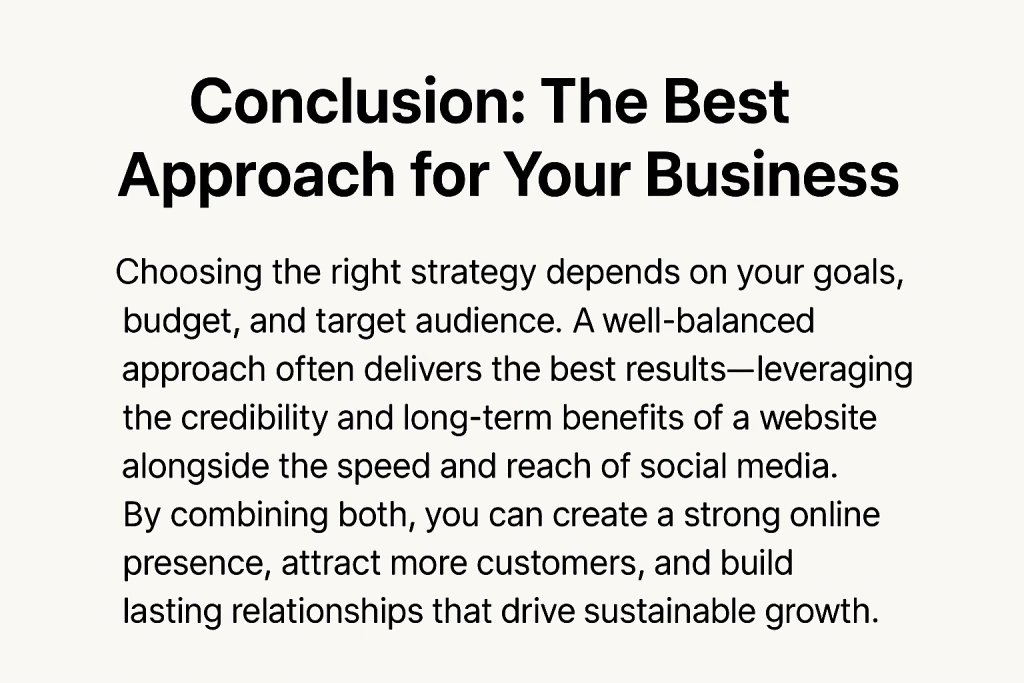
The question is no longer whether to use websites or social media. It is about how to use the two in synergy to achieve your business goals. The best path will vary by industry, audience, budget, and goals.
Important Points to Remember:
- Websites can provide long-term benefits in terms of search engine optimization, credibility and mechanism for conversion improvement.
- Social media provides immediate capabilities to reach and engage audiences.
- Integration can drive both by providing a momentum with both platforms.
- How you budget is based on where you are as a business and what your main goals are.
- Success is built on consistent work no matter the platforms you select.
Recommendations for Next Steps
- Leverage the fundamentals: At a minimum build a professional website and be active on 1 or 2 social platforms.
- Think like your audience: When selecting platforms consider where your audience will be operating and most active.
- Measure and adjust: Let your data guide your decision making and allocation of resources.
- Stay flexible: Keep the reality that your social media platforms and audience will change over time.
- Think long: Build systems that are sustainable over time and need to grow with your business over time.
And keep in mind, the digital world is constantly changing. What works now, may change tomorrow. The businesses that will likely continue to succeed are the businesses that will be flexible to change, make data-driven decisions that are focused on their customer and still meet their brand messaging channels across all digital platforms they touch.
Regardless of whether you choose to focus on websites or social media, the best way to achieve success is to provide real value to the audience and build relationships beyond any one platform or technology fad.
This thorough guide offers a framework for you to make informed choices about your digital marketing strategy. Just remember that for tailored recommendations on your specific business needs, etc., you may want to consult with digital marketing professionals who can assess your individual situation and map out a customized plan.

